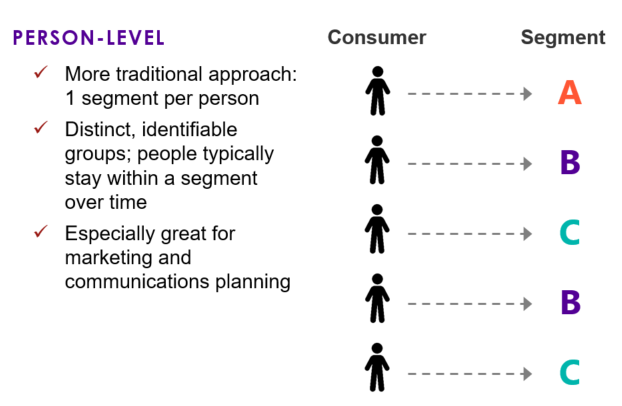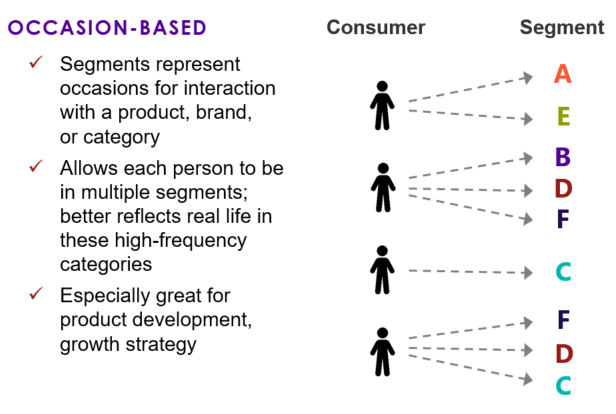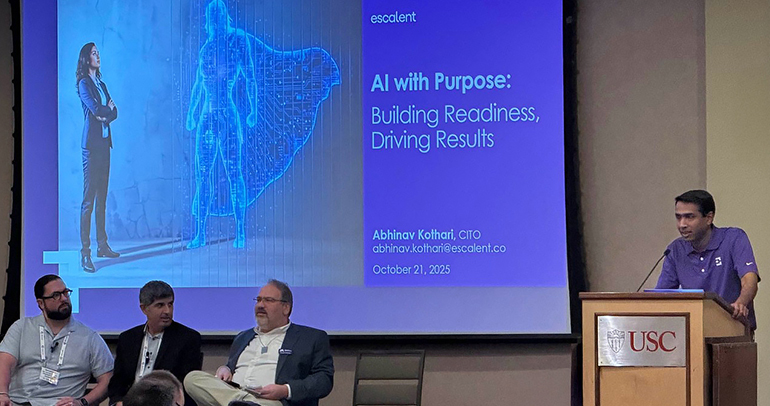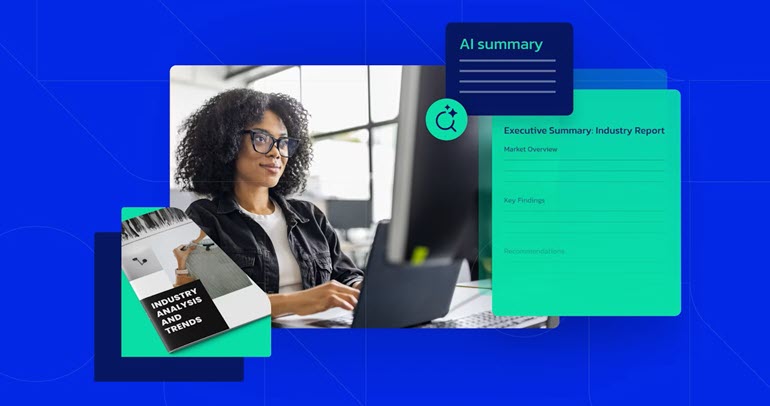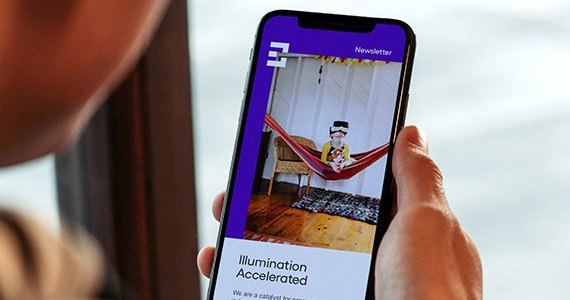
Kathryn is an interior designer with three children. Today, she’s shopping online for her weekly stock-up of groceries that she’s scheduling to be dropped off at her doorstep at 5:30 pm, once she’s wrapped up work for the day. Two days later, she’s ordering flour and cocoa for curbside pick-up because her children reminded her she had promised to make her infamous chocolate cake as a Friday night treat. On Saturday, she picks up a rotisserie chicken and potato wedges as a quick and easy pre-made dinner.
Although Kathryn is the same customer purchasing food from the same store, she shops each time for very different reasons. As a marketer, knowing when and where she shops, why, and what she’s looking for gives important guidance on how to communicate with her, as well as guidance on how to develop products, experiences and programs to reach her. That’s why segmenting your audience is so important—segmentation provides this very guidance.
But when it comes to segmentation, one size doesn’t fit all. While traditional segmentation might be a good solution for planning marketing and communications strategies for many brands, it often falls short when you apply it to moderate- and high-frequency categories such as clothing, food and beverage, restaurants, CPG, personal care items and travel and leisure. Instead of segmenting by people, segmenting by occasion or interaction with your brand or category could be a better option.
In this blog, we’ll explore the differences between traditional and occasion-based segmentation, when to use each, and how occasion-based segmentation can help you develop more impactful products and growth strategies in higher frequency categories.
Traditional vs. Occasion-Based Segmentation
Segmentation, whether traditional person-based or occasion-based, isn’t new. But many of our clients, particularly those in high-frequency categories, have been asking about how to make their segmentation more actionable. The first step is to understand the differences between traditional and occasion-based segmentation.
Traditional Segmentation
Traditional segmentation blends several different dimensions of consumers like perceptions, attitudes, behaviors, and demographics to uncover distinct and identifiable groups of people. This approach is particularly effective for marketing and communications planning, and is intuitive for business users to understand because each person is assigned to one segment. Also, the segments are stable—each person typically stays within that segment—which allows you to build rich consumer profiles to help better understand your customers.
For instance, let’s say you want to market your newest model of wireless ear phones. According to your research and data, you might create an audience segment named “First and Fresh” that looks like the following: mostly males, aged 35-44 who always upgrade to the latest smartphone as soon as it comes out, prefer the iOS operating system, consider themselves tech savvy, and view having the latest technology as a status symbol. As you can see, this example brings in demographics like age, purchasing behaviors, technology preferences, attitudes and values.
Occasion-Based Segmentation
If consumers interact with your brand or category more often, their needs, motivations and behaviors become much more important because those naturally vary for each purchase. That means each brand interaction will be most valuable if you can relate to a consumer’s exact emotional or psychological state in just the right moment. That’s the premise of occasion-based segmentation. This approach creates differentiated and identifiable segments. However, those segments represent occasions for interaction with your product, brand or category. Unlike traditional segmentation, one person will likely experience or belong to multiple segments, or occasions.
Beverages are a good example of an industry in which occasion-based segmentation works well because people consume products based on their needs. While a consumer might prefer to drink juice in the morning, she could opt for a soft drink during lunch and a bottle of water later in the afternoon. Those choices will likely change based on a variety of factors such as day of the week, time of day, who she’s with, her specific need (such as thirst or energy boost) or her mood.
For instance, let’s say you want to market your energy drinks but data show there are different motivations driving consumption occasion which could require different marketing messages. Using this scenario, let’s focus in on two occasions: “Late Night Recharge” and “Mid-Afternoon Workday Slump.”
When it comes to the “Late Night Recharge” occasion, consumers are looking for a late night pick-me-up where they can get a burst of energy to take them from dinner through catching up with friends. Since this is a post-meal occasion, they want a small quantity beverage that packs a lot of punch and seek out a small format drink. Those who experience this occasion tend to be younger men and women who are somewhat more health focused and are just starting out in their careers.
But, when it comes to the “Mid-Afternoon Workday Slump” occasion, consumers are seeking out a mid-day surge of energy to help them get through the last bit of their hectic workday. In this occasion, they typically pick up a 24 oz or larger energy drink, preferably flavored. They often pair it with a sweet snack for a little extra boost of sugar. Those who experience this occasion tend to be men and women, ages 25-40, who are working professionals and highly motivated to advance in their careers.
As you see here, now we’re focused on the motivation behind the occasion itself, rather than just the person. These two occasions are quite different and so is the consumer’s choice of energy drink. However, we also see in the data that the same consumer might experience both occasions regularly.
Why Choose Occasion-Based Segmentation?
Occasion-based segmentation helps you understand the distinct occasions in which consumers purchase and interact with products or categories. Since it’s done on the category level, and not just for the brand, you can find out where you’re performing well, and discover new opportunities for growing your brand or market share.
Because occasion-based segmentation provides a wide range of data that you can analyze in a variety of ways, it works especially well for improving product development, growth strategy, brand and shopper strategy, marketing and communications. It is best in categories in which consumers interact with the product or service often and their need states, motivations, situations, and behaviors around each purchase vary—coffee, alcoholic beverages, going out to eat, personal care items, app purchases, and video/streaming content rentals and purchases are just a few examples.
On the other hand, this type of segmentation isn’t very effective for infrequent categories such as buying a new car or new laptop, or those where there isn’t typically a varying need or situation driving the purchase, such as buying cat litter or a phone charger.
Occasion-based segmentation is also flexible, letting you take a narrow or wide focus. For example, you can choose to segment for several related product lines within the same category, different types of consumers or different channels. And finally, you can mine and reanalyze the data as new questions come up, stretching the value of that data over time.
Surge Ahead with Segmentation
Making the switch from traditional to occasion-based segmentation requires a shift in thinking about how you find, think about and use your segments. But for moderate to high-frequency categories, the returns are worth it. With more actionable occasion segments, you can develop better products, boost your business growth, and build communications around the occasions that help move your brand further than you ever thought possible.
If you’re not seeing results with your current segmentation strategies, send us a note. Using proven research methods and our industry expertise, we’ll help you choose the solution that’s right for your business.
Originally published June 11, 2019. Last updated February 5, 2021.
